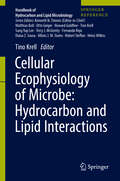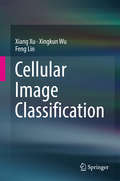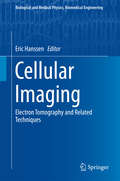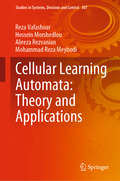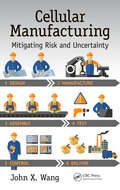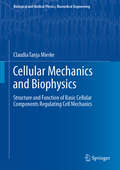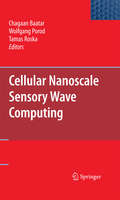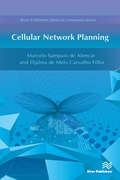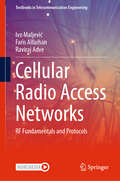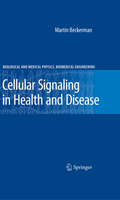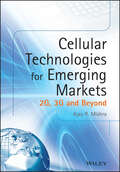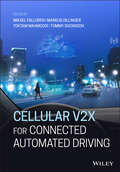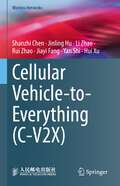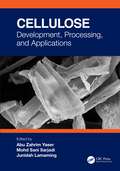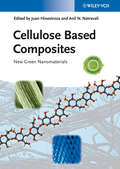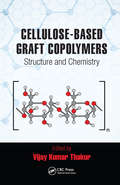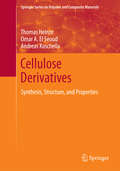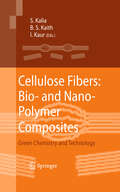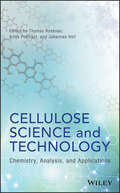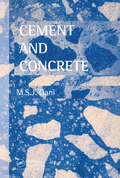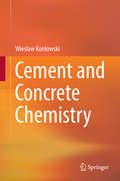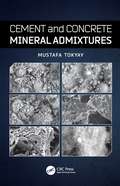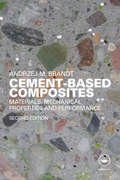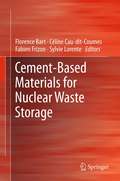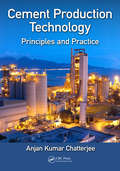- Table View
- List View
Cellular Ecophysiology of Microbe: Hydrocarbon and Lipid Interactions
by Tino KrellThis book assembles concisely written chapters by world-leaders in the field summarizing recent advances in understanding microbial responses to hydrocarbons. Subjects treated include mechanisms of sensing, hydrocarbon tolerance and degradation as well as an overview on hydrophobic modification of biomolecules. Other chapters are dedicated to issues related to the reduced bioavailability of hydrocarbons, which differentiates this class of compounds form many others, but which of central importance to understand the ecophysiological consequences. This book should be standard literature in any laboratory working in this area.
Cellular Image Classification
by Xiang Xu Xingkun Wu Feng LinThis book introduces new techniques for cellular image feature extraction, pattern recognition and classification. The authors use the antinuclear antibodies (ANAs) in patient serum as the subjects and the Indirect Immunofluorescence (IIF) technique as the imaging protocol to illustrate the applications of the described methods. Throughout the book, the authors provide evaluations for the proposed methods on two publicly available human epithelial (HEp-2) cell datasets: ICPR2012 dataset from the ICPR''12 HEp-2 cell classification contest and ICIP2013 training dataset from the ICIP''13 Competition on cells classification by fluorescent image analysis. First, the reading of imaging results is significantly influenced by one''s qualification and reading systems, causing high intra- and inter-laboratory variance. The authors present a low-order LP21 fiber mode for optical single cell manipulation and imaging staining patterns of HEp-2 cells. A focused four-lobed mode distribution is stable and effective in optical tweezer applications, including selective cell pick-up, pairing, grouping or separation, as well as rotation of cell dimers and clusters. Both translational dragging force and rotational torque in the experiments are in good accordance with the theoretical model. With a simple all-fiber configuration, and low peak irradiation to targeted cells, instrumentation of this optical chuck technology will provide a powerful tool in the ANA-IIF laboratories. Chapters focus on the optical, mechanical and computing systems for the clinical trials. Computer programs for GUI and control of the optical tweezers are also discussed. to more discriminative local distance vector by searching for local neighbors of the local feature in the class-specific manifolds. Encoding and pooling the local distance vectors leads to salient image representation. Combined with the traditional coding methods, this method achieves higher classification accuracy. Then, a rotation invariant textural feature of Pairwise Local Ternary Patterns with Spatial Rotation Invariant (PLTP-SRI) is examined. It is invariant to image rotations, meanwhile it is robust to noise and weak illumination. By adding spatial pyramid structure, this method captures spatial layout information. While the proposed PLTP-SRI feature extracts local feature, the BoW framework builds a global image representation. It is reasonable to combine them together to achieve impressive classification performance, as the combined feature takes the advantages of the two kinds of features in different aspects. Finally, the authors design a Co-occurrence Differential Texton (CoDT) feature to represent the local image patches of HEp-2 cells. The CoDT feature reduces the information loss by ignoring the quantization while it utilizes the spatial relations among the differential micro-texton feature. Thus it can increase the discriminative power. A generative model adaptively characterizes the CoDT feature space of the training data. Furthermore, exploiting a discriminant representation allows for HEp-2 cell images based on the adaptive partitioned feature space. Therefore, the resulting representation is adapted to the classification task. By cooperating with linear Support Vector Machine (SVM) classifier, this framework can exploit the advantages of both generative and discriminative approaches for cellular image classification. The book is written for those researchers who would like to develop their own programs, and the working MatLab codes are included for all the important algorithms presented. It can also be used as a reference book for graduate students and senior undergraduates in the area of biomedical imaging, image feature extraction, pattern recognition and classification. Academics, researchers, and professional will find this to be an exceptional resource.
Cellular Imaging: Electron Tomography and Related Techniques (Biological and Medical Physics, Biomedical Engineering)
by Eric HanssenThis book highlights important techniques for cellular imaging and covers the basics and applications of electron tomography and related techniques. In addition, it considers practical aspects and broadens the technological focus by incorporating techniques that are only now becoming accessible (e. g. block face imaging). The first part of the book describes the electron microscopy 3D technique available to scientists around the world, allowing them to characterize organelles, cells and tissues. The major emphasis is on new technologies like scanning transmission electron microscopy (STEM) tomography, though the book also reviews some of the more proven technologies like electron tomography. In turn, the second part is dedicated to the reconstruction of data sets, signal improvement and interpretation
Cellular Learning Automata: Theory and Applications (Studies in Systems, Decision and Control #307)
by Reza Vafashoar Hossein Morshedlou Alireza Rezvanian Mohammad Reza MeybodiThis book highlights both theoretical and applied advances in cellular learning automata (CLA), a type of hybrid computational model that has been successfully employed in various areas to solve complex problems and to model, learn, or simulate complicated patterns of behavior. Owing to CLA’s parallel and learning abilities, it has proven to be quite effective in uncertain, time-varying, decentralized, and distributed environments. The book begins with a brief introduction to various CLA models, before focusing on recently developed CLA variants. In turn, the research areas related to CLA are addressed as bibliometric network analysis perspectives. The next part of the book presents CLA-based solutions to several computer science problems in e.g. static optimization, dynamic optimization, wireless networks, mesh networks, and cloud computing. Given its scope, the book is well suited for all researchers in the fields of artificial intelligence and reinforcement learning.
Cellular Manufacturing: Mitigating Risk and Uncertainty (Systems Innovation Book Series)
by John X. WangIn today's business world, competitiveness defines the industrial leading edge. Organizations and businesses of all sizes are adopting Lean manufacturing practices to increase efficiency and address worries about their bottom lines. In a detailed review of this staple of Lean manufacturing, Cellular Manufacturing: Mitigating Risk and Uncertainty ou
Cellular Mechanics and Biophysics: Structure and Function of Basic Cellular Components Regulating Cell Mechanics (Biological and Medical Physics, Biomedical Engineering)
by Claudia Tanja MierkeThis book focuses on the mechanical properties of cells, discussing the basic concepts and processes in the fields of immunology, biology, and biochemistry. It introduces and explains state-of-the-art biophysical methods and examines the role of mechanical properties in the cell/protein interaction with the connective tissue microenvironment. The book presents a unique perspective on cellular mechanics and biophysics by combining the mechanical, biological, physical, biochemical, medical, and immunological views, highlighting the importance of the mechanical properties of cells and biophysical measurement methods. The book guides readers through the complex and growing field of cellular mechanics and biophysics, connecting and discussing research findings from different fields such as biology, cell biology, immunology, physics, and medicine. Featuring suggestions for further reading throughout and addressing a wide selection of biophysical topics, this book is an indispensable guide for graduate and advanced undergraduate students in the fields of cellular mechanics and biophysics.
Cellular Nanoscale Sensory Wave Computing
by Tamas Roska Wolfgang Porod Chagaan BaatarThis book is a result of a Multidisciplinary University Research Initiative (MURI) project that has been funded by the Office of Naval Research and completed recently. The results manifest a new way of thinking about sensory computing, as well as being one of the first successful attempts to bridge the gap between nanoscale (smaller than 100 nm) devices and CMOS integrated circuits with stored programmable algorithms and software on the system level. In this book the emerging and converging architecture of morphic cellular wave computers based on the concept of Cellular Neural/Nonlinear Network (CNN) is introduced in a practical way. The book also discusses the architecture and operation of a vision system on a chip (VSoC) which is in the first single chip cellular wave computer.
Cellular Network Planning (River Publishers Series In Communications Ser.)
by Marcelo Sampaio Alencar Djalma de Melo Carvalho FilhoOver the recent years, few books have been published covering all the subjects needed to understand the very fundamental concepts of cell planning. Most books which deal with this topic are destined to very specific audiences, and the vast majority introduce the subject at a very basic, or technical, level, or are destined to an academic audience. Cellular Network Planning begins with an introduction to the subject, covering conventional and contemporary wireless systems. Spectral allocation and the frequency plan are discussed, along with the essential characteristics of wireless systems. The design of mobile cellular systems includes cell planning, traffic and channel problems. The book presents a review of existing models, considering both green field dimensioning and network expansion strategies, and discusses multi-objective optimization and base station deployment based on artificial immune systems. It also discusses a cost-effective base station deployment approach based on artificial immune systems, and introduces the modified MO-AIS algorithm.
Cellular Radio Access Networks: RF Fundamentals and Protocols (Textbooks in Telecommunication Engineering)
by Ivo Maljević Faris Alfarhan Raviraj AdveThis textbook goes to the heart of telecommunications engineering by developing the underlying concepts and linking them to how system specifications are determined by standards bodies – and how systems are designed and implemented by equipment manufacturers. In this regard, the book is comprehensive in covering all important aspects of wireless networks. Tailored to undergraduate/graduate students and practicing engineers, this book presents the fundamental concepts in a concise manner, while retaining the rigor needed to truly understand wireless communications. Importantly, the book ties these developments to how these concepts are implemented in fielded systems, discussing the motivations behind the design choices made in 4G and 5G wireless communications. The book bridges the gap between theory and application, presenting key practical issues. Presents RF concepts, RAN protocols, and radio planning and optimization; Bridges the gap between theoretical and application-driven textbooks on cellular radio access networks; Includes a full suite of classroom materials including PowerPoint slides, a solutions manual, and tutorials.
Cellular Signaling in Health and Disease (Biological and Medical Physics, Biomedical Engineering)
by Martin BeckermanIn today's world, three great classes of non-infectious diseases - the metabolic syndromes (such as type 2 diabetes and atherosclerosis), the cancers, and the neurodegenerative disorders - have risen to the fore. These diseases, all associated with increasing age of an individual, have proven to be remarkably complex and difficult to treat. This is because, in large measure, when the cellular signaling pathways responsible for maintaining homeostasis and health of the body become dysregulated, they generate equally stable disease states. As a result the body may respond positively to a drug, but only for a while and then revert back to the disease state. Cellular Signaling in Health and Disease summarizes our current understanding of these regulatory networks in the healthy and diseased states, showing which molecular components might be prime targets for drug interventions. This is accomplished by presenting models that explain in mechanistic, molecular detail how a particular part of the cellular signaling web operates properly in health and improperly in disease. The stability of the health- and disease-associated states is dynamic and supported by multiple feedback loops acting positively and negatively along with linkages between pathways. During the past few years an ongoing series of important discoveries have been made that advance our understanding of how the body works and may guide us on how to better deal with these diseases. These include the discovery of chronic inflammation as a causal factor in all of these disease classes, the appearance of reactive oxygen species as a messenger molecule that can act both positively and negatively, the propensity of proteins to misfold into aggregation- and disease-prone forms, and the rise of epigenetics including the emergence of small non-coding RNA with important regulatory functions out of the so-called junk RNA. Chapters are devoted to each of these classes of findings with additional details integrated into the chapters dealing directly with the diseases. The connections responsible for maintaining stability are explored in depth.
Cellular Technologies for Emerging Markets: 2G, 3G and Beyond
by Ajay R. MishraIn this book, the author addresses technologies that are being used in emerging cellular markets. These include GSM/EGPRS and CDMA which are being deployed at a rapid pace, while technologies such as UMTS (3G)/ HSPA (3.5G) which have started to find a place in these high growth markets, are also considered. The book examines other technologies including LTE (3.9G) which have already moved out of research labs into the commercial world. 2G-CDMA is widely used, while further developments, e.g. CDMA2000 are also finding acceptance in the commercial arena. IMS/Convergence is increasingly popular all over the world; UMA, which is deployed mostly in North America; and DVB which is gaining worldwide popularity, especially in South Asia, are all reviewed.Each chapter discusses a different technology and is structured into three parts. The technology is examined at an overview level, first explaining what the technology is and then considering the technical features of the technology. The chapter concludes by looking at the planning/implementation aspects of the technology.Key Features:Useful for all cellular industry professionals as provides an overview of the currently deployed technologies in mass scale, and the forthcoming technologies that are expected to make an impact in the future, such as 4th Generation Cellular Networks. One of the first books on the market to encompass all the major cellular technologies, as well as considering the design and implementation perspective. Wireless Technology will play a key role in uplifting the economies of the Emerging countries globally. Ashok Chandra, Wireless Advisor to Govt. of India
Cellular V2X for Connected Automated Driving
by Mikael Fallgren Markus Dillinger Toktam Mahmoodi Tommy SvenssonA unique examination of Cellular Vehicle-to-Everything technologies in automated vehicles, combining expert perspectives and technical information from industry and academia Cellular Vehicle-to-Everything (C-V2X) technologies enable vehicles to communicate both with the network and with each other using reliable, responsive, secure, and high-capacity communication links. Cellular V2X for Connected Automated Driving provides an up-to-date view of the role of C-V2X technologies in advanced driving support, improved road safety, and the future large-scale transition to self-driving vehicles. This timely book discusses where C-V2X technology is situated within the increasingly interconnected ecosystems of the mobile communications and automotive industries. An expert contributor team from both industry and academia explore potential applications, business models, standardization, spectrum and channel modelling, network enhancements, security and privacy, and more. Broadly divided into two parts—introductory and advanced material—the text first introduces C-V2X technology and explores a variety of use cases and opportunities, requiring no prerequisite technical knowledge. The second part of the book assumes a basic understanding of the field of telecommunications, presenting technical descriptions of the radio, system aspects, and network design for the previously discussed applications. This up-to-date resource: Provides technical details from the finding of the EC H2020 5G PPP 5GCAR project, a collaborative research initiative between the telecommunications and automotive industries and academic researchers Offers use cases, business models, and a technology roadmap for those seeking to shape a start-up in the area of automated and autonomous driving Addresses the challenges in serving different vehicles at different automation levels Features illustrations of the concept, technical plots and diagrams, and photos of the test and trials performed by the 5GCAR project Includes detailed tables, plots, and equations to clarify concepts, accompanied by online tutorial slides and for use in teaching and seminars Thanks to its mix of introductory content and technical information, Cellular V2X for Connected Automated Driving is a must-have for industry and academic researchers, telecom and automotive industry practitioners, leaders, policymakers, and regulators, and college-level instructors and students.
Cellular Vehicle-to-Everything (Wireless Networks)
by Shanzhi Chen Jinling Hu Li Zhao Rui Zhao Jiayi Fang Yan Shi Hui XuThis book focuses on cellular Vehicle-to-Everything (C-V2X), currently the most promising wireless communication technology for Vehicle-to-Vehicle (V2V), Vehicle-to-Infrastructure (V2I), Vehicle-to-Pedestrian (V2P), Vehicle-to-Network (V2N) and Vehicle-to-Cloud (V2C) communications. Because of its low latency and high reliability, C-V2X has become an essential enabling technology for Intelligent Transportation Systems (ITSs) and autonomous driving. This book begins by introducing readers to the research background and status quo of global development. Then, after analyzing the performance requirements of various V2X applications, the system architecture and technical standards are presented. The two evolving stages of C-V2X, i.e., LTE-V2X and NR-V2X, are introduced in detail. In addition, related technologies such as mobile edge computing, network slicing and high-precision positioning, C-V2X security, C-V2X spectrum requirements and planning, and industrial development and applications are introduced. In closing, the book discusses future applications of and technical challenges for C-V2X. This book is the first monograph dedicated to C-V2X, offering experts, researchers and engineers from the areas of IT/CT, intelligent transportation, intelligent and connected vehicles (ICVs) an in-depth understanding of C-V2X technology and standards, while also outlining related interdisciplinary research. The book can also be used as a reference resource for both undergraduate and graduate studies.
Cellulose: Development, Processing, and Applications
by Abu Zahrim YaserCellulose: Development, Processing, and Applications covers topics related to advanced cellulose development and processing, as well as the utilization of major agricultural and biomass waste. It discusses the utilization of cellulose from other agricultural and biomass materials, including oil palm biomass, bamboo, and other non-wood forest products in emerging areas. It covers the treatments used to improve the quality of cellulosic materials in specific applications. Following that, the book delves into the use of cellulosic materials in the application of composting science and technology. Features: Delves into the specific agriculture waste/biomass waste materials used for the advanced cellulose-based production Outlines the potential use of the covered materials for energy production and other emerging applications Includes composting technology and processes using the cellulosic materials Overviews industrial applications of cellulose from agricultural waste/biomass waste and composting technology Discusses the main agricultural waste/biomass in the Asian region This book is aimed at researchers and graduate students in chemical engineering, bioprocessing, composites, and biotechnology.
Cellulose Based Composites
by Anil Narayan Netravali Juan HinestrozaAimed at researchers involved in this emerging field in both academia and industry, this book is unique in its focus on cellulose nanofibers, especially nano-composites, nanomoities and other plant based-resins and their composites. Despite its concise presentation, this handbook and ready reference provides a complete overview, containing such important topics as electrospinning, isolation, characterization and deposition of metallic nanoparticles.
Cellulose-Based Graft Copolymers: Structure and Chemistry
by Vijay Kumar ThakurCellulose-Based Graft Copolymers: Structure and Chemistry discusses the synthesis, characterization, and properties of multifunctional cellulose-based graft copolymers. Presenting the contributions of accomplished experts in the field of natural cellulosic polymers, this authoritative text: Offers an overview of cutting-edge technical accomplishmen
Cellulose Derivatives
by Thomas Heinze Omar A. El Seoud Andreas KoschellaThis book summarizes recent progress in cellulose chemistry. The last 10 years have witnessed important developments, because sustainability is a major concern. Biodegradable cellulose derivatives, in particular esters and ethers, are employed on a large scale. The recent developments in cellulose chemistry include unconventional methods for the synthesis of derivatives, introduction of novel solvents, e.g. ionic liquids, novel approaches to regioselective derivatization of cellulose, preparation of nano-particles and nano-composites for specific applications. These new developments are discussed comprehensively. This book is aimed at researchers and professionals working on cellulose and its derivatives. It fills an important gap in teaching, because most organic chemistry textbooks concentrate on the relatively simple chemistry of mono- and disaccharides. The chemistry and, more importantly, the applications of cellulose are only concisely mentioned.
Cellulose Fibers: Green Chemistry and Technology
by Susheel Kalia B. S. Kaith Inderjeet KaurBecause we are living in an era of Green Science and Technology, developments in the field of bio- and nano- polymer composite materials for advanced structural and medical applications is a rapidly emerging area and the subject of scientific attention. In light of the continuously deteriorating environmental conditions, researchers all over the world have focused an enormous amount of scientific research towards bio-based materials because of their cost effectiveness, eco-friendliness and renewability. This handbook deals with cellulose fibers and nano-fibers and covers the latest advances in bio- and nano- polymer composite materials. This rapidly expanding field is generating many exciting new materials with novel properties and promises to yield advanced applications in diverse fields. This book reviews vital issues and topics and will be of interest to academicians, research scholars, polymer engineers and researchers in industries working in the subject area. It will also be a valuable resource for undergraduate and postgraduate students at institutes of plastic engineering and other technical institutes.
Cellulose Science and Technology: Chemistry, Analysis, and Applications
by Thomas Rosenau Antje Potthast Johannes HellThis book addresses both classic concepts and state-of-the-art technologies surrounding cellulose science and technology. Integrating nanoscience and applications in materials, energy, biotechnology, and more, the book appeals broadly to students and researchers in chemistry, materials, energy, and environmental science.• Includes contributions from leading cellulose scientists worldwide, with five Anselm Payen Cellulose Award winners and two Hayashi Jisuke Cellulose Award winners• Deals with a highly applicable and timely topic, considering the current activities in the fields of bioeconomies, biorefineries, and biomass utilization• Maximizes readership by combining fundamental science and application development
Cement and Concrete
by M.S.J GanCement and concrete are of great interest to the construction and civil engineering communities. This study provides an appreciation of the complex nature of these materials and a realization that most of the failures involving concrete constructions are preventable.
Cement and Concrete Chemistry
by Wieslaw KurdowskiThis monograph describes cement clinker formation. It covers multicomponent systems, clinker phase structures and their reactions with water, hydrate composition and structure, as well as their physical properties. The mineral additions to cement are described as are their influence on cement-paste properties. Special cements are also discussed. The microstructure of concrete is then presented, and special emphasis is given to the role of the interfacial transition zone, and the corrosion processes in the light of cement-phase composition, mineral additions and w/c ratio. The admixtures' role in modern concrete technology is described with an emphasis on superplasticizer chemistry and its cement-paste rheological modification mechanism. Cement with atypical properties, such as calcium aluminate, white, low energy and expansive cements are characterized. The last part of the book is devoted to special types of concrete such as self compacting and to reactive powders.
Cement and Concrete Mineral Admixtures
by Mustafa TokyaySupplementary cementing materials and other mineral admixtures are being used in increasing amounts in both cement and concrete. Their main technical benefits are that they enhance the workability of fresh concrete and the durability of hardened concrete. Indeed, they affect almost every property of the concrete. Their economic and ecological benef
Cement-Based Composites: Materials, Mechanical Properties and Performance, Second Edition
by Andrzej M. BrandtCement-Based Composites takes a different approach from most other books in the field by viewing concrete as an advanced composite material, and by considering the properties and behaviour of cement-based materials from this stance. It deals particularly, but not exclusively, with newer forms of cement-based materials. This new edition takes a crit
Cement-Based Materials for Nuclear Waste Storage
by Céline Cau-di-Coumes Sylvie Lorente Fabien Frizon Florence BartAs the re-emergence of nuclear power as an acceptable energy source on an international basis continues, the need for safe and reliable ways to dispose of radioactive waste becomes ever more critical. The ultimate goal for designing a predisposal waste-management system depends on producing waste containers suitable for storage, transportation and permanent disposal. Cement-Based Materials for Nuclear-Waste Storage provides a roadmap for the use of cementation as an applied technique for the treatment of low- and intermediate-level radioactive wastes. Coverage includes, but is not limited to, a comparison of cementation with other solidification techniques, advantages of calcium-silicate cements over other materials and a discussion of the long-term suitability and safety of waste packages as well as cement barriers.
Cement Production Technology: Principles and Practice
by Anjan Kumar ChatterjeeThe book is an outcome of the author’s active professional involvement in research, manufacture and consultancy in the field of cement chemistry and process engineering. This multidisciplinary title on cement production technology covers the entire process spectrum of cement production, starting from extraction and winning of natural raw materials to the finished products including the environmental impacts and research trends. The book has an overtone of practice supported by the back-up principles.
